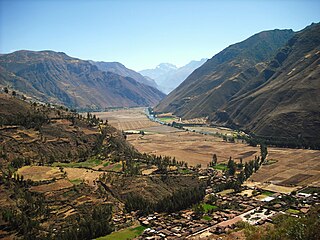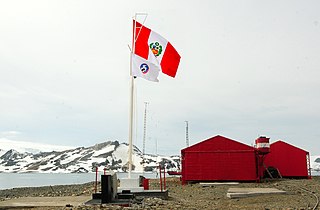Related Research Articles

Machu Picchu is a 15th-century Inca citadel located in the Eastern Cordillera of southern Peru on a 2,430-meter (7,970 ft) mountain ridge. Often referred to as the "Lost City of the Incas", it is the most familiar icon of the Inca Empire. It is located in the Machupicchu District within Urubamba Province above the Sacred Valley, which is 80 kilometers (50 mi) northwest of Cusco. The Urubamba River flows past it, cutting through the Cordillera and creating a canyon with a tropical mountain climate. In reference to the site's name, for most English or Spanish speakers, the first 'c' in Picchu is silent. In English, the name is pronounced MAH-choo PEE-choo or MATCH-oo PEAK-choo, in Spanish as or, and in Quechua as.

Ciro Alegría Bazán was a Peruvian journalist, politician, and novelist.

The Sacred Valley of the Incas, or the Urubamba Valley, is a valley in the Andes of Peru, north of the Inca capital of Cusco. It is located in the present-day Peruvian region of Cusco. In colonial documents it was referred to as the "Valley of Yucay." The Sacred Valley was incorporated slowly into the incipient Inca Empire during the period from 1000 to 1400.

Písac or Pisac is a Peruvian town in the Sacred Valley of the Incas. It is situated on the Vilcanota River. Pisac is most known for its Incan ruins and large market which attracts heavy tourist traffic from nearby Cusco.

Real Jardín Botánico de Madrid is an 8 hectares botanical garden in Madrid (Spain). The public entrance is located at Plaza de Murillo, next to the Prado Museum.

The Machu Picchu arboreal chinchilla rat is a large species of South American chinchilla rats, known from skeletal remains found by members of the Peruvian Expedition of 1912. The animals were buried alongside people in ancient Inca tombs at Machu Picchu in Peru. It was considered extinct by the IUCN in 2008, but conservation status was changed to data deficient in 2016. Photos of a rodent taken at Machu Picchu in late 2009 likely show this species, a finding apparently confirmed in 2014.

The Machu Picchu Scientific Base is a Peruvian polar scientific research facility in Antarctica, established to conduct Antarctic research on geology, climatology and biology. More specifically, its purpose is to study the continent's geological past, potential sea resources, wind strengths, air pollution, and the animal adaptation in a freezing environment. The base is named after the World Heritage Site Machu Picchu.

Marcahuamachuco is an archeological site of Pre-Incan ruins in the La Libertad Region of Peru. Although less well-known than other sites, it is considered significant and has been referred to by archaeologists as "Machu Picchu of the North" and "The Jewel of La Libertad."

Thierry Jamin is a French explorer and pseudohistorian known for his research about Paititi and the presence of the Incas and pre-Inca civilization in the Amazonian rainforest.

The Peru–Yale University dispute was a century-long conflict between the government of Peru and Yale University about the rightful ownership of Inca human remains and artifacts from Machu Picchu, an ancient Inca site high in the Peruvian Andes active c. 1420–1532. In the several years following his re-discovery of Machu Picchu in 1911, Yale explorer Hiram Bingham III removed thousands of objects – including pottery, stone tools, and human bones – from the archaeological site and brought them to New Haven, Connecticut. The circumstances of these transfers were disputed, with some, including Bingham, claiming that Yale agreed to borrow the artifacts for a period of 18 months to conduct studies. Peru attempted to regain the collection in the 1920s, but Yale resisted. Tensions rose between 2006 and 2010 with a lawsuit, activism by Peruvians and Yale alumni, and a plea to then–U.S. President Barack Obama by then–Peruvian President Alan Garcia. On November 19, 2010, Peru and Yale reached an agreement that the remains and artifacts would be returned. In early 2011, Yale and University of Cusco (UNSAAC) signed a further agreement that the two institutions would partner to create a museum and research center in Cusco. The museum, the Museo Machu Picchu, was opened to the public in November 2011. The collection is regarded by experts to be among the most valuable collections of Inca artifacts.

The Jardín Etnobotánico de Oaxaca is a botanical garden in Oaxaca City, Mexico. It occupies 2.32 acres of land adjacent to the Church of Santo Domingo. It is administered by the state government of Oaxaca.

The Trujillo Botanical Garden is a botanical garden located in the city of Trujillo, Peru. It is located on America Sur Avenue, 1 mile (0.6 km) south of the main city square in La Merced neighborhood. The 6.5-acre garden contains 250 catalogued plant species, in addition to a number of unidentified plants among its collections.

The Park of Legends, formally the Dr. Felipe Benavides Barreda Park of Legends, is a zoo located in San Miguel District, Lima, Peru. It is managed by the Metropolitan Municipality of Lima (MML). It is the most influential and visited zoo in the entire capital, featuring recreation and entertainment areas, archaeological museums, a botanical garden, among other facilities.

Quito Botanical Garden is a park, botanical garden, arboretum and greenhouse of 18,600 square meters in the city of Quito, Ecuador. It houses species of plants of the country.
References
- ↑ "Site museum and botanical garden in Machu Picchu". Imachupicchu. 11 May 2024. Retrieved 11 May 2024.
- ↑ "Jardín Etnobotánico Nugkui". Botanic Gardens Conservation International. 11 May 2024. Retrieved 11 May 2024.
- ↑ "Jardín Etnobotánico Felipe Marin Moreno Pisaq". Botanic Gardens Conservation International. 11 May 2024. Retrieved 11 May 2024.
- ↑ "Jardín Botánico". Parque de Las Leyendas. 11 May 2024. Retrieved 11 May 2024.